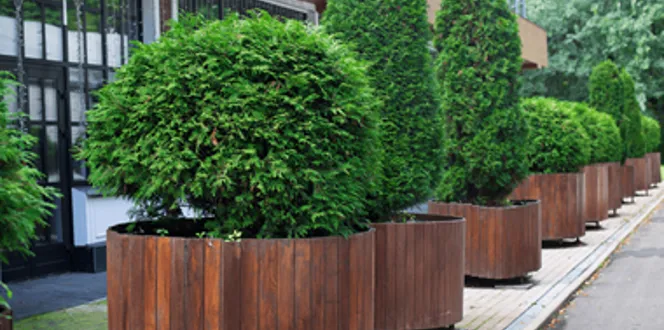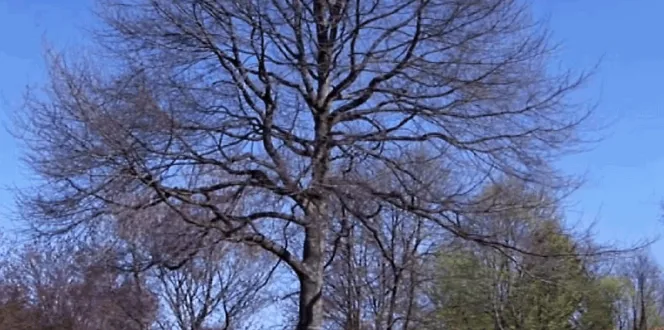There may come a time when a tree needs to relocate to a more suitable spot in your yard.
Moving a tree comes with risks, but when you take your time and follow a tree transplanting checklist to a tee, there’s a much better chance your tree will have a smooth transition.
Below, read about how to make the transplanting process as painless as possible for your tree.
The Best Time To Transplant Trees
There are two good tree transplanting windows throughout the year: in fall after leaves drop and before the ground freezes, or in early spring before growth starts. The idea is to transplant a tree while it’s dormant. Most trees can be transplanted anytime during these general time frames, but here’s when to transplant trees including pine, oak, maple, and fruit.
How To Replant A Small Tree
First, let’s talk about what counts as a small tree.
For transplanting purposes, a small tree is any tree that has a trunk diameter of 2 inches or less. To get a good read on diameter, wrap measuring tape around the trunk 4 feet from the ground, pinpoint the circumference in inches and then divide that by pi (3.14).
Now, follow these steps to transplant a small tree:
- Dial 881. Or, go to call811.com. This service helps you locate underground utilities to ensure you’re planting the tree in the right place.
- Figure out root ball size. Remember, trees that are more than 2 inches in diameter are considered large, so for those, skip to the next section. For small trees, the width of the root ball should be around 8 to 12 inches wide for each inch of trunk diameter. For example, a tree that’s 1 1/2 inches in diameter needs a root ball that’s 12 to 18 inches wide. But wait! Before you uproot the tree, complete steps 3 and 4.
- Water the soil. Water 1 or 2 days before you transplant—that’ll make the process much smoother.
- Dig a new home. Once you’ve picked the right place to plant, dig a hole that’s 2 or 3 times the width of the root ball and 1 or 2 inches deeper than the height of the root ball. It’s important to have the new planting site ready to go so you limit the amount of time the tree’s roots are exposed. (Keep these measurements in mind when finding a new spot for your tree!)
- Trench around tree roots. With a sharp spade, dig a circle around tree roots to create a root ball that’s the width you calculated in step 2. Dig down 1 to 2 feet, and then cut under the roots to round out the root ball.
- Transport the tree. Here’s where you’ll really want to take your time (and where it would be good to have an extra pair of hands.) Keeping the root ball secure is essential to the tree’s survival. To do that, cut a piece of burlap that’s large enough to cover the entire root ball. Then, carefully tip the root ball onto one side, and put the burlap in the hole. Roll the root ball onto the burlap, wrap it and secure it with twine. Lift the tree out of the hole from the bottom, making sure not to lift by the trunk. Then, gently carry the tree to the new planting spot.
- Plant the tree. Place the tree in its new hole with the top of the root ball just slightly (no more than an inch or two) above ground level. Planting trees too deep is a pretty common mistake, but this handy video on planting trees at the proper depth will help you get it right. When the tree is in place, cut and remove the burlap and twine, and then fill the hole with soil from the original planting site.
- Protect from transplant shock. The tree is set, but your job is not quite done! Water the tree thoroughly right after transplanting, and then follow these steps to protect your tree from the stress of transplant shock.
How To Transplant A Large Tree
Transplanting a large tree is pretty similar to the procedure for a small one. But, it’s best to not try to tackle this project on your own. Here’s why:
- Sharp spades that can cut through thin and small tree roots might not work for large roots. Usually, you need heavy-duty equipment to dig and lift large trees.
- Root balls on large trees can weigh a lot. They’re much harder to pick up and carefully place in a new hole.
- One of the most important parts of the transplanting process is keeping a tree’s root ball intact. That’s much harder to do with large trees, and roots can easily get damaged in the shuffle.
Trees with trunks larger than 2 inches in diameter should be transplanted by a professional arborist. Arborists will have the right tools and experience to safely get your tree from point A to point B.





